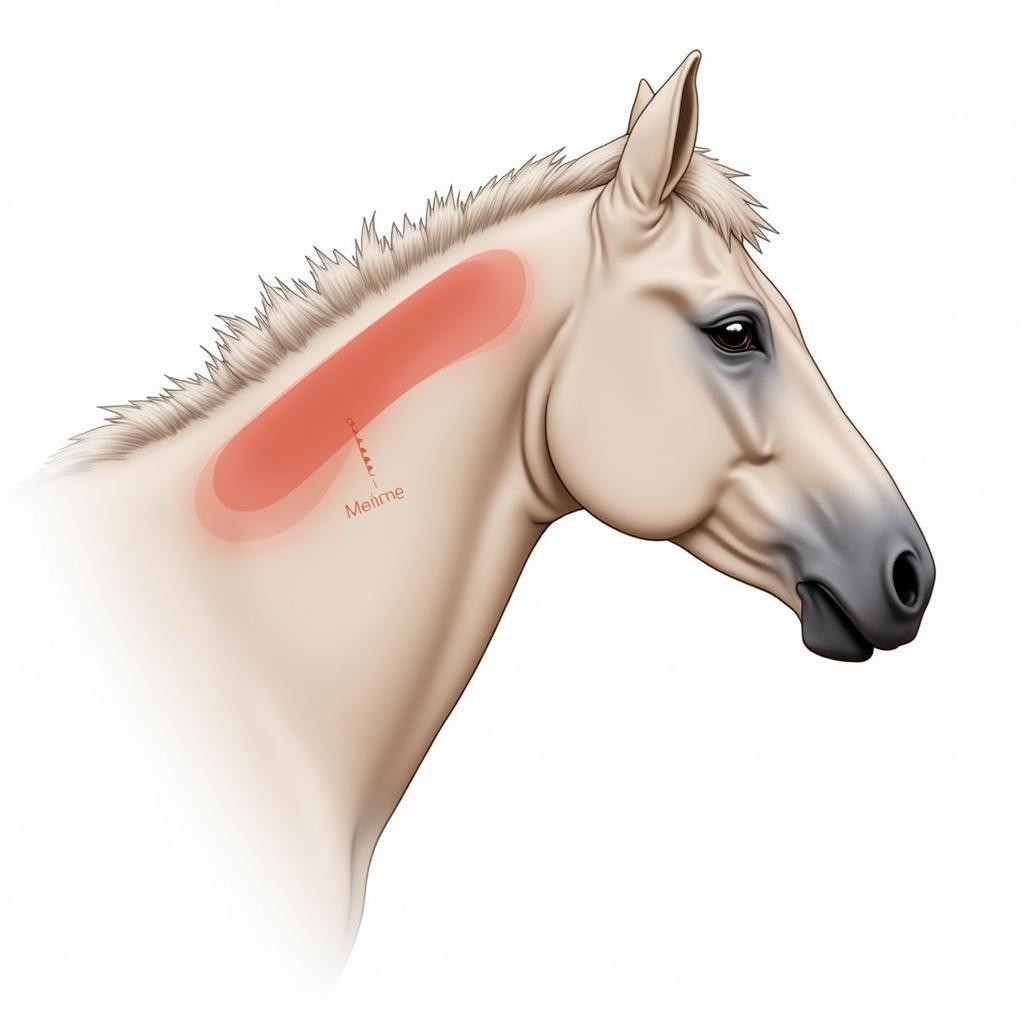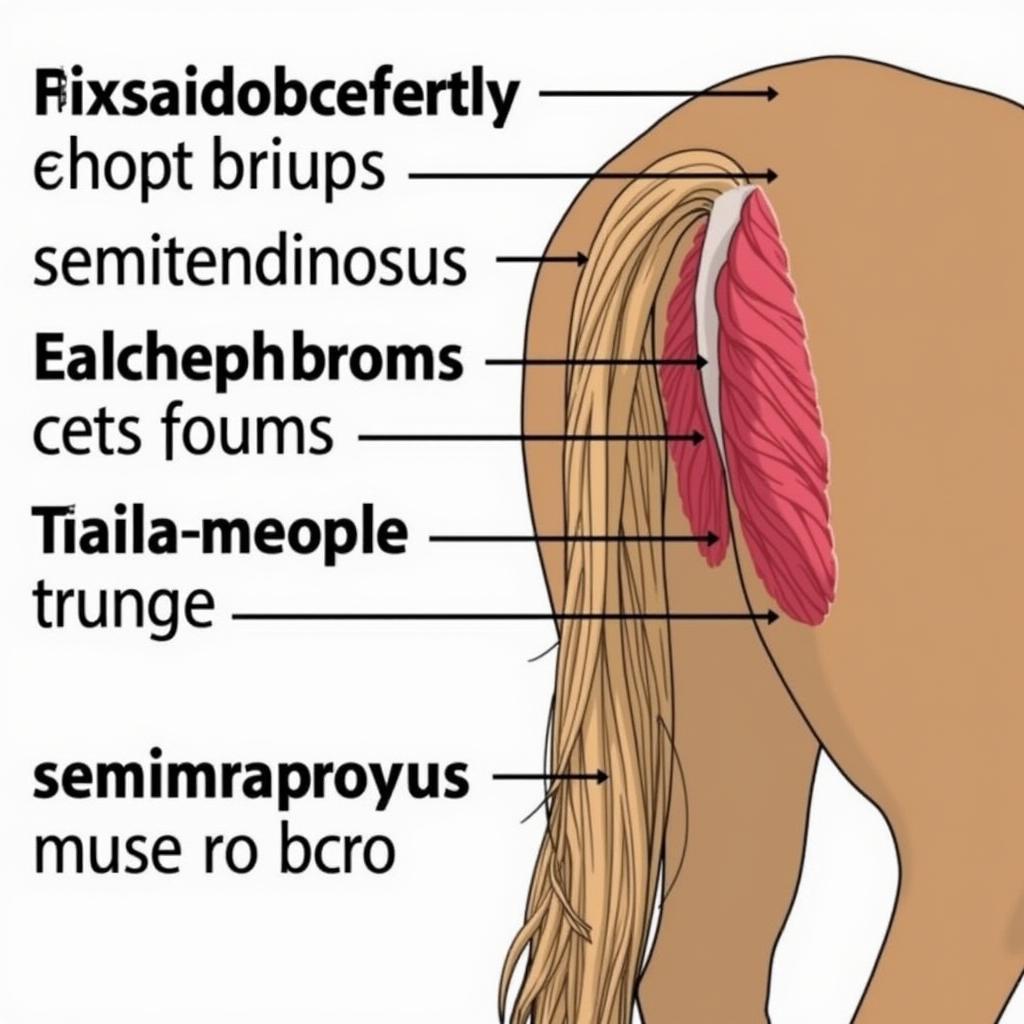Understanding the proper sites for administering injections in horses is crucial for their well-being. This guide provides a detailed overview of intramuscular (IM), subcutaneous (SC), and intravenous (IV) injection sites in horses, emphasizing best practices for safe and effective medication administration.
Intramuscular Injection Sites in Horses: Where Precision Matters
IM injections deliver medication directly into the muscle, allowing for rapid absorption. However, choosing the correct location is vital to prevent complications.
The Neck Muscles: A Common Choice
The neck muscles are often preferred for IM injections due to their accessibility and large muscle mass.
- Triangle of the Neck: This area, formed by the nuchal ligament, shoulder blade, and cervical vertebrae, offers a safe zone for injections.
- Considerations: Avoid injecting into the upper third of the neck, close to the nuchal ligament, as it can lead to muscle damage and potential complications.
 Horse Neck Injection Site
Horse Neck Injection Site
The Semitendinosus and Semimembranosus Muscles: Alternatives
These hindquarter muscles, located on the back of the thigh, offer alternative sites for IM injections, especially for large volumes.
- Locating the Muscles: The semitendinosus and semimembranosus muscles are easily identifiable by palpating the back of the thigh.
- Cautions: Injecting into the wrong area within these muscle groups can damage nerves and blood vessels.
 Horse Hindquarter Injection Site
Horse Hindquarter Injection Site
“Choosing the correct IM injection site is not just about finding a muscle; it’s about understanding the underlying anatomy and potential risks,” says Dr. Emily Carter, DVM, an equine veterinarian with over 20 years of experience.
Subcutaneous Injections in Horses: Under the Skin
Subcutaneous injections deliver medication into the layer of fat just beneath the skin, offering slower absorption than IM injections.
Where to Administer SC Injections:
- The Neck: The loose skin on the side of the neck, just behind the ears, is a common site for SC injections.
- The Chest: The area behind the point of the elbow on the chest can also be used for SC injections.
Important Reminders:
- Tent Technique: Always use the tent technique when administering SC injections to ensure the medication is delivered into the subcutaneous tissue and not into the muscle.
- Needle Size: Use a smaller gauge needle for SC injections compared to IM injections.
Intravenous Injections in Horses: A Delicate Procedure
IV injections deliver medication directly into the bloodstream, offering the fastest absorption rate but requiring specialized training and caution.
The Jugular Vein: The Preferred Site
The jugular vein, located on either side of the horse’s neck, is typically used for IV injections.
- Restraint is Key: Proper restraint of the horse is essential to prevent movement during IV injection.
- Veterinary Expertise: IV injections should only be performed by a qualified veterinarian or under their direct supervision.
“Administering IV injections in horses is not a DIY procedure,” warns Dr. Carter. “It requires a thorough understanding of equine anatomy and sterile technique to ensure the safety and well-being of the animal.”
Recognizing Potential Complications
While injections are common in equine medicine, it’s crucial to be aware of potential complications.
- Swelling and Pain: Some swelling and pain at the injection site are normal, but excessive swelling, heat, or lameness could indicate an infection or reaction.
- Abscess Formation: An abscess is a localized collection of pus that can develop at the injection site.
- Allergic Reactions: Horses can have allergic reactions to medications, which can manifest as hives, swelling, or difficulty breathing.
When to Contact a Veterinarian
If you notice any unusual swelling, pain, or discharge at the injection site, or if your horse exhibits signs of an allergic reaction, contact your veterinarian immediately.
Conclusion
Understanding proper Horse Injection Sites is paramount for ensuring safe and effective medication administration. By following best practices and working closely with your veterinarian, you can help keep your equine companion healthy and thriving.
For more information on horse health and care, visit our other resources on dectomax for horses dosage and neck threadworms in horses pictures.
Need immediate assistance with your horse? Contact us at Phone Number: 0772127271, Email: [email protected] or visit us at QGM2+WX2, Vị Trung, Vị Thuỷ, Hậu Giang, Việt Nam. Our dedicated team is available 24/7 to address your concerns.